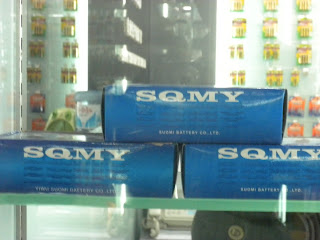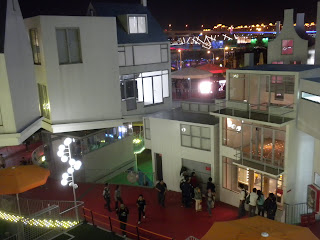I went to the World Expo with a friend last week, finally getting a chance to see the US, Canada, Brazil, Chile, Mexico, Netherlands, Italy, and a bevy of South American country pavilions. The scale and order of the whole affair certainly impressed me, but, to be honest, I was underwhelmed. With all the hype about the Expo (I guess it's only hype if you live in Shanghai), you expect to be blown away with the food, music, culture, and people of other countries. However, it's more like a museum; most countries have a building which they use to display artifacts, to show videos, to sell souvenirs, etc. without offering food samples and having bands play local music as I had expected (and they say I couldn't plan an Expo)

The immense China Pavilion. I've heard that the pavilion gives out tickets when it opens at 9 am with time slots for the rest of the day, but I'm sure people start lining up much earlier. Needless to say, I didn't see the inside. My friend and I arrived at the Expo around 2 pm and stayed until its close at 10:30 pm. I heavily doubted this strategy, but it ended up working for us. We only stood on one line over 15 minutes, which was Italy for 35 minutes (granted, a friend works for the US pavilion so she got us into the VIP entrance). However, other students have had stories of waiting in one line for an hour and a half, and newspapers have said that some lines have grown up to four to five hours.

Haibao, which means treasure of the sea, is the Expo's mascot (the picture is from Google). The meaning is an obvious reference to Shanghai, which is using this Expo to become a modern city on the world stage, much as Beijing used the Olympics. Shanghai's tourist destinations are overflowing with Haibaos in whatever form you can imagine them, but surprisingly the Expo had a muted Haibao presence. Its (his, her?) figure is based on the Chinese character 人, pronounced ren, which means people. However, most of my friends are still of the opinion that it's a drop of toothpaste or Gumby.

The ceiling of a room in the Brazil pavilion. Brazil had many interactive screens to learn about the country and to see videos of its land. However, your time at any screen was limited by the hordes of people peeping over your shoulders. For this reason, each pavilion is a mix of a museum and entertainment center. They want to educate you about their country but quickly enough so that they can cycle through the next group of visitors waiting in line. Brazil did a decent job due to its graffiti art and large four-sided video screen in another room.

A sign in the Chile pavilion. Chile was unique from the other pavilions, and I thoroughly enjoyed it. They had a wall depicting an apartment building with unique scenes of daily life in each window; their message seemed to be that we need to put more effort into understanding our neighbors and each other. Obviously, the message had a lot more to do with modernity than Chile itself, but we'll forgive that point. To make up for it, they had a well with a camera of someone in Chile since the country is exactly opposite Shanghai on the globe.
The Panama pavilion. Joining several Central and South American countries, Panama was housed in a building with several other pavilions. Unfortunately, this picture was the extent of the pavilion, which was the size of half of a basketball court. My first reaction was ridicule, but I soon stopped to think about the Expo's value for individual countries.
Unless you're a country like the US or Australia about which the Chinese people are curious, the Expo probably isn't worth it, not just in dollar terms but also in good will and international relations terms. The Expo is about exposing your country to the Chinese people, but at the end of the day, the Expo is about China, its ability to host a Expo and to build such an immense pavilion. Chinese people obviously formed the bulk of Expo-goers, and many seemed to be from outside Shanghai. They may look at the Peru or Mexico pavilions and get their Expo passbook stamped with the country's name, but what they're going to remember is the pride of walking into the China pavilion, the curiosity of walking into the US pavilion, the spectacle of the Saudi Arabia or Russia pavilions. I'm mixing up many storylines in this paragraph, but it is interesting to think about the Expo from each POV: the Chinese visitor, China itself, large countries like the US, small countries like Panama, the thousands of Chinese citizens whose houses were re-located to secure this space, the staff in each pavilion, the distant government of each country, etc. What does the Expo accomplish? What is its purpose? Different things for each actor. Is it worth it for each of them? No idea.

A screen in the Canada pavilion. The theme of the Expo is "Better City, Better Life", which relates to urban sustainability and environmental consciousness. Most pavilions displayed a country's efforts towards sustainability, future plans, etc. at least in some form. These plans were heartening, but they seemed a bit overdone. What percentage of these plans are actually being implemented around the world? After all, we are in China where a carbon-neutral hotel can be built for foreign Expo visitors with a horribly polluting factory located, I'm sure, less than 50 km away. By no means am I saying that the emphasis was hypocritical (after all, China is attempting to address its environmental problems in much larger ways than Western media lets on), but it seemed as if the atmosphere was celebrating these so-called conquered challenges rather than acknowledging the immense work ahead.
I'll quickly mention a point a class speaker raised last week. Environmentalism is intricately tied into modernity, the image of progressiveness. The Shanghai Tower, which will be the second-tallest building in the world when completed, is billed as a sustainable building with wind turbines and rainwater collection. The speaker's point was that countries used to compete on the height of their buildings, the time required to put a man on the moon, etc. Now another element of that competition is sustainability, why else would they add those features to the world's second-tallest building? You could even say that sustainability is in vogue. Whether environmentalism for competition or modernity sake is a bad thing, you decide for yourself

Glasses I temporarily took from a vendor outside the US pavilion. Call it patriotism, call it unsophisticatedness, call it whatever, but I loved the US pavilion. Like Chile, it was unique in having a message, but unlike Chile, the message was intricately related to the US. The pavilion tried to humanize Americans, to say that we respect China as equals and that we can work together to achieve common goals like sustainability. It was over the top at times, but I still loved it for what it was trying to do.
The pavilion was a series of three videos in different rooms. In the first video, random Americans try to speak Chinese phrases and utterly fail. It could be seen as offensive, but I think people understood it was meant to be amusing. The second video was an amalgamation of Americans from Kobe Bryant to schoolchildren to businesswomen to Obama. They spoke on different themes, but the takeaway seemed to be our ability to collaborate with China and our respect for its culture. Obama's words made me cringe a little, but they were certainly on point about expanding relations, both diplomatic and personal, between two of the world's most powerful countries and richest cultures. The third video was silent and showed a girl's perseverance to build a garden in a vacant lot with the help of her neighbors. As you can tell, the creators didn't leave much room for misinterpretation, especially when they included a Chinese neighbor. The fourth room displayed the pavilion's corporate sponsors (it was entirely privately funded).
The Netherlands pavilion. Of the pavilions that were collections of artifacts without any message (all the countries I saw except Chile and the US), I liked the Netherlands the most. Why? Well, they had the most artifacts. There was a solar-powered car, Van Gogh paintings, clocks, plastic lamb, brief plaques on science inventions, etc. With its odd winding structure, this pavilion was quite an experience.

The Italy pavilion. Even though it was the longest line of the day, it was certainly worth it. From the architecture to the fashion to the Ferraris to the pasta, it's easy to forget how much Italy has going for it. The current economic and political situation may not be hopeful, but the pavilion certainly didn't reflect it. The pavilion was an airy, pleasant walk-through that advertised the 2015 World Expo in Milan on your way out.
On the whole, the Expo was one of those things-you-have-to-do-if-you're-in-town experiences. I didn't think it was amazing, but it was pleasant and memorable. The content of the pavilions raised many questions about sustainability, international relations, Chinese views, the impact on Shanghai, etc. Like everyone else, I conveniently ignored them as I raced to the next pavilion
 I'm not sure what this man was doing, probably feeding the fish that are often put in the lakes of gardens, but he fit perfectly into the background. If I were a wealthy official in ancient China, I would definitely pay a worker just to sit there all day while I enjoyed this idyllic setting.
I'm not sure what this man was doing, probably feeding the fish that are often put in the lakes of gardens, but he fit perfectly into the background. If I were a wealthy official in ancient China, I would definitely pay a worker just to sit there all day while I enjoyed this idyllic setting. A stone bridge, another idyllic setting typical of a garden. Apparently the construction and maintenance of a garden is closely tied to feng shui, although that's the extent of my knowledge. I imagine stone bridges and pagodas help the garden achieve (or maintain or be or whatever verb is appropriate in this context) feng shui
A stone bridge, another idyllic setting typical of a garden. Apparently the construction and maintenance of a garden is closely tied to feng shui, although that's the extent of my knowledge. I imagine stone bridges and pagodas help the garden achieve (or maintain or be or whatever verb is appropriate in this context) feng shui
















































